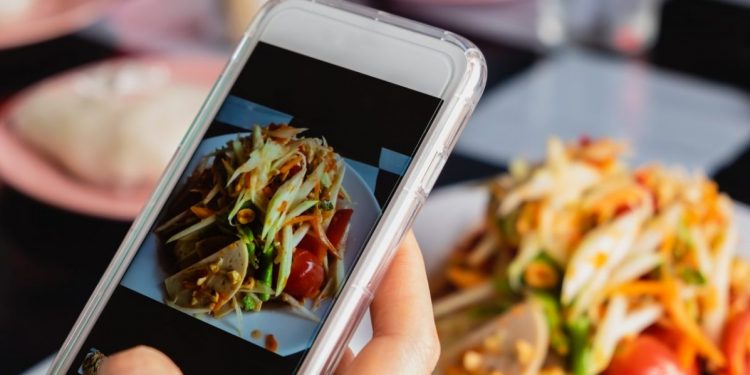This article is contributed by Labour Member of Parliament and NTUC Assistant Secretary-General Melvin Yong. Any extracts must be attributed to the author. 20 June 2020.
The circuit breaker has been a tough period for all Singaporeans, especially our beloved hawkers and wet market stallholders. Many, in particular the 20 to 30 per cent of hawkers who decided to temporarily close their stalls during the circuit breaker period, heaved a sigh of relief when it was announced that Singapore will be going into phase two of circuit breaker on 19 June 2020!
However, if you think life will resume to pre-COVID-19 times, think again.

The experiences of other countries are telling. In China, over 100 million people faced renewed lockdown in the North-eastern region with scores of flights to and from Beijing being cancelled and some neighbourhoods being blocked off. In Japan, Hokkaido suffered a second wave of COVID-19 infections after lifting lockdown measures; while in South Korea, new clusters have formed quickly after lockdown restrictions were eased, forcing closures of more than 250 schools just days after they re-opened.
So even as we entered the second phase of reopening our economy yesterday, experts and economists have cautioned that Phase 2 could last for months. Therefore, it is important for our hawkers to adapt to the new ‘Dabao’ culture, as it will be a period of time before life returns to ‘business-as-usual’ and even then, it may not be the ‘business-as-usual’ that we are accustomed to pre-COVID-19.
Can Our Hawkers Thrive in a Post-COVID-19 Landscape? Yes, They Can!

In the face of uncertainty, I am glad to see that many hawkers have decided to take this opportunity and embrace the new digital age, banding together to survive. Ground-up initiatives, such as Hawkers United – Dabao 2020 Facebook Group and SG Dabao, have sprung up to give hawkers with a platform to promote their offerings to a wider audience.
The Government has also stepped in by providing grants and financial incentives for hawkers to digitalise. In April 2020, the National Environment Agency (NEA) announced an initiative to provide cooked food stallholders with a one-off financial assistance of $500 to help with the costs of signing up with delivery platforms. Through the Digital Resilience Bonus, SMEs in the Food Services industry can receive additional funding support of up to $10,000 to help them digitise quicker. The existing Hawkers’ Productivity Grant has also been expanded to include more hawkers, beyond just the cooked food stallholders, to help fund the purchase of equipment that can help shorten food preparation time and increase productivity. Not forgetting the new SG Digital Office, which will outreach to some 18,000 hawkers and 100,000 seniors, to help them go digital.
Despite such assistance provided, when I spoke to second-generation hawker, Melvin Chew, and his fellow hawkers who manage the Hawkers United Facebook group, they told me that the fear of technology is still there for many older hawkers. Fortunately, these problems are not insurmountable and in fact, many elderly hawkers and market stallholders have already shown us that they can adapt to the ‘new normal’. All they need is a little help!
Hence, ground outreach efforts and the recent Hawkers Go Digital programme by the Infocomm Media Development Authority, will not only be the key in helping our hawkers and showing them that digitalisation is not as daunting as it sounds but will also extend a helping hand and a little encouraging nudge to hawkers in their road to digitalisation.
Tekka Online Market, a First of Its Kind!
During the circuit breaker, the Infocomm and Media Development Authority (IMDA) taught wet market stallholders from Tekka Centre how to sell their produce using Facebook Livestream. I showed my support by making the first order for some boxes of fresh mushrooms during their first livestream.
It was my first time making an online purchase from a wet market stall through Facebook, and it was also the first time for all the stallholders. Despite being new to this, many stallholders gamely stepped up to the challenge and received many supportive comments. Today, a number of stallholders have started to live stream on their own.
One of them is Mohamed Mustafa, the owner of Haji M N Shahul Hameed Marketing. Like many hawkers and stallholders, 61-year-old Mohamed’s business has been affected by the circuit breaker and social distancing measures. However, thanks to the help of the IMDA, he has learnt how to live stream via Facebook and sell his mutton online
Mohamed told me that he now live streams regularly on Fridays, and online sales have made up for the drop in business caused by the pandemic. He tells me that on a good day, all his stocks are snapped up within 15 minutes of live streaming! Going online also meant that he can now reach out to customers from far away, and he has recently made deliveries to new customers in Woodlands and Punggol.
“Using Facebook to live stream is not difficult at all. All you need is a handphone and a laptop, and you can even tap on Government grants to purchase the equipment,” said Mohamed when asked if it was difficult to learn how to live stream.
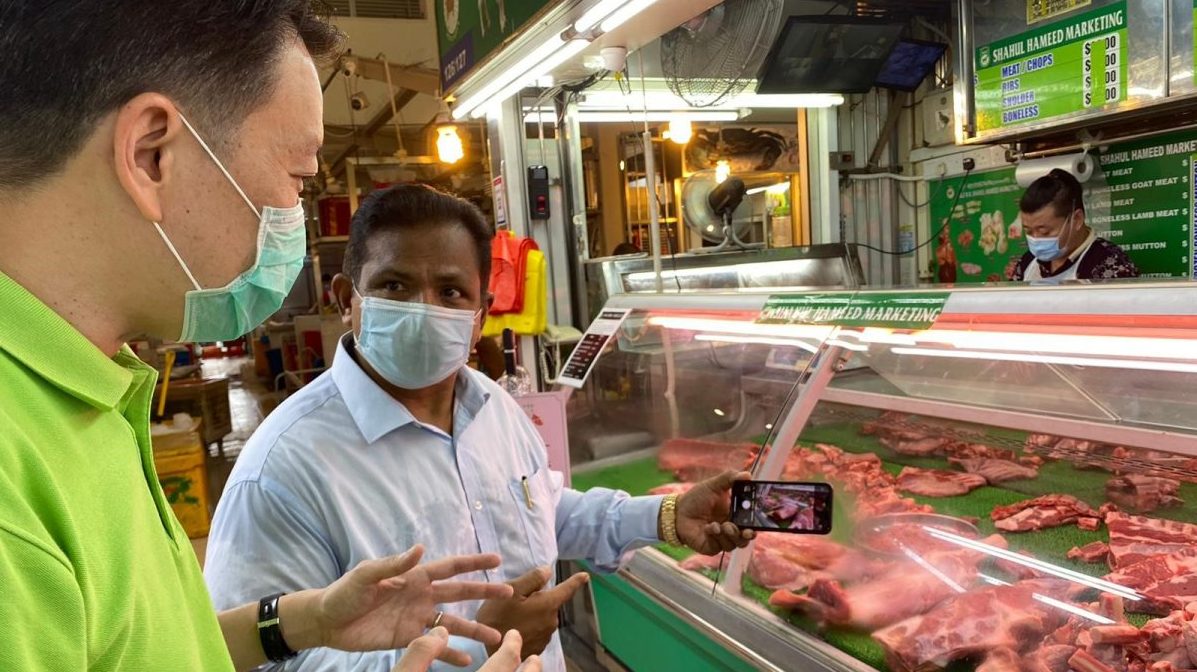
Another stallholder who has embraced live streaming is Lee Bee Bee, the owner of Lim Siew Keow Dried Foods. 50-year-old Bee Bee heard about the Tekka Online Market from her fellow stallholders and decided to try her hand at live streaming. Together with her 28-year-old nephew, they live stream every Sunday, which accounts for about 10 per cent of their sales.
“My nephew helped me to reach out to IMDA and they gave him tips on how to do the live stream. We operate a very simple setup. Just one handphone is good enough to get started,” said Bee Bee.
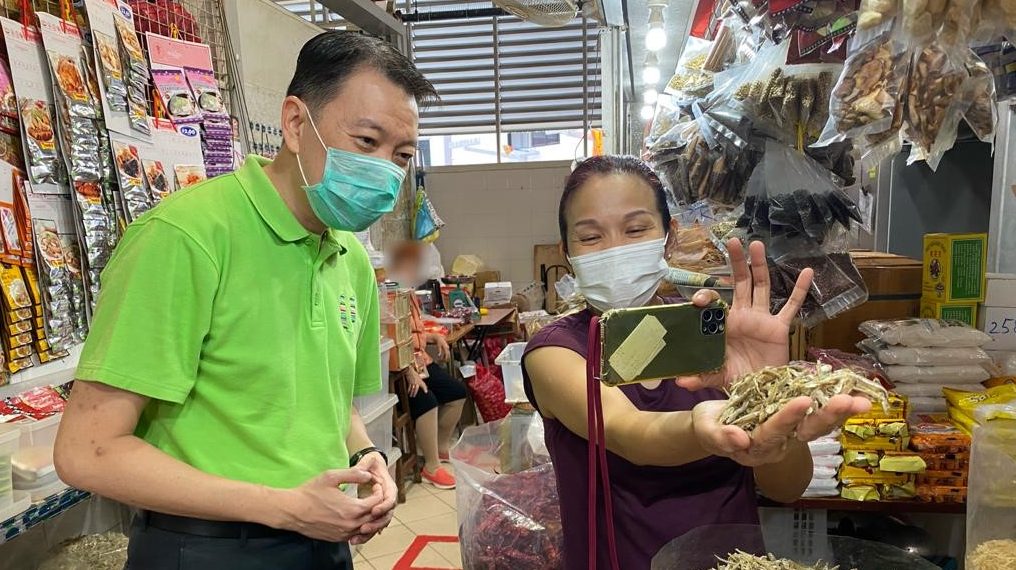
The reinvention of our wet market stallholders to become “web market superstars” shows us that our hawkers and stallholders can all adapt and seize opportunities in this new normal. Hence, we want to help and support them to do so easily!
Working with Partners to Make It Easier for Hawkers
Partnering with Take.sg to Improve the Ordering Experience
With most of the ordering done online during this period, it is important to ensure that customers have a smooth ordering experience while ensuring that stallholders can cope with the order volume during peak periods.
That is why we reached out to Take.sg to see if we could work together to provide a smooth ordering experience for both customers and hawkers. Youmin Kim, founder of Take.sg, created a Whatsapp ordering form, to help hawkers capture orders easily through Whatsapp. Youmin told me he created the free platform to help hawkers and restaurants who were overwhelmed by the number of WhatsApp orders they received on a daily basis.
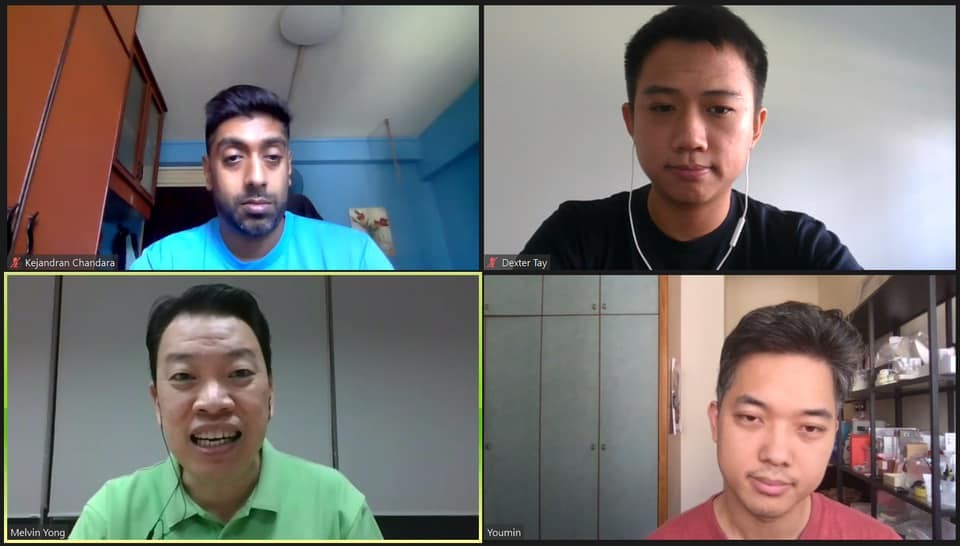
I am happy to share that Take.sg will continue working with Moulmein-Cairnhill to further improve the user experience on the platform, catering towards our more elderly hawkers. We will also look at improving the backend inventory system to cater specifically to our wet market stallholders.
“I think that this is a good initiative to collaborate on, as it is important for us to help hawkers, wet market stallholders, and mom-and-pop grocery shops to survive in the digital world,” said Youmin, whose day job is an engineer at Facebook.
Partnering with nEbo’s Photography Interest Group
During my engagement sessions, one important feedback that stood out to me was that hawkers find it difficult to take ‘Instagram-worthy’ or appetising photos of their food to post online. To help them, I have roped in the help of nEbO’s photography interest group. nEbO is the junior membership arm of NTUC.
To kick off this project, five nEbO volunteers who are photography enthusiasts will volunteer their time to help hawkers and wet market stallholders in Pek Kio Market and Tekka Market take photos of their food and products which will then be uploaded ontoTake.sg.
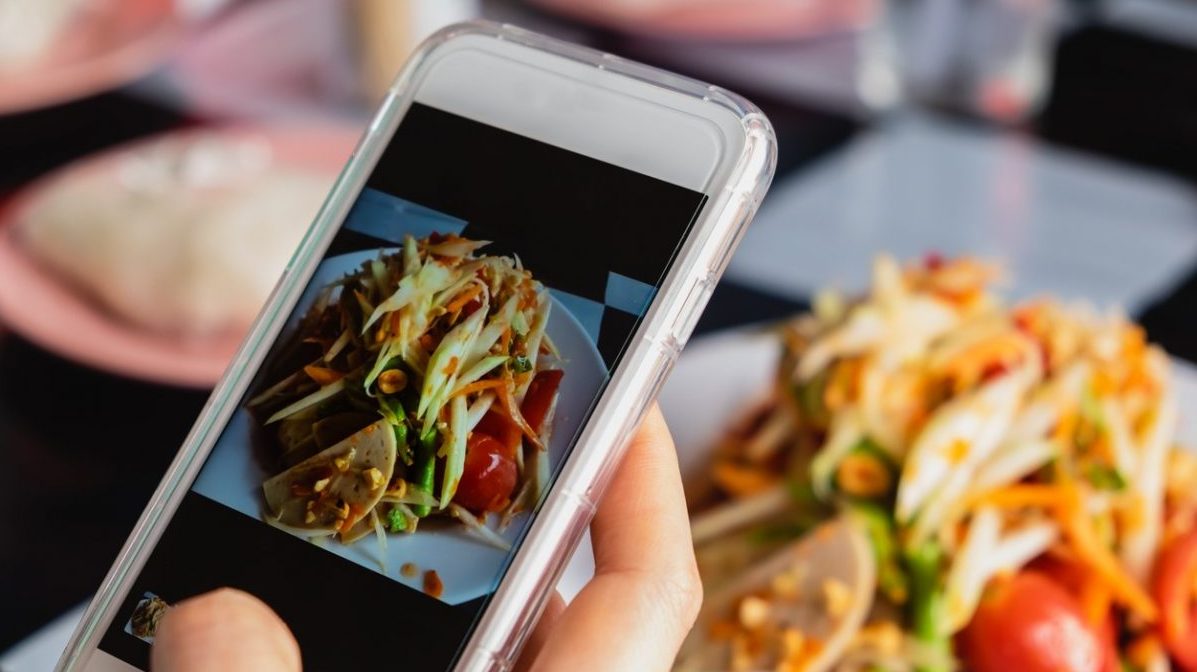
Support for Hawkers Paramount in Helping Them Ride Through COVID-19
Our hawkers are a resilient lot. While many may have been unfamiliar with e-commerce and food delivery in the past, they have now embraced it in a bid to survive.
We can and need to do more to aid our hawkers in their transformation to Hawker 4.0. I firmly believe that we can lower food delivery commission fees, which are currently a key entry barrier for many hawkers. The collaboration between NTUC Fairprice and WhyQ, which will charge zero commission fees to our hawkers, is a great initiative.
Let us continue to support our hawkers and preserve our beloved hawker culture. In the meantime, dabao, dabao, dabao!

